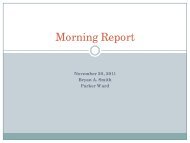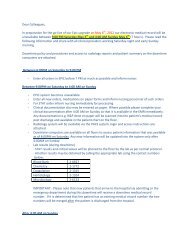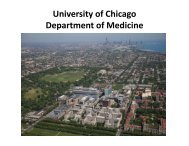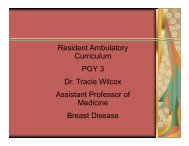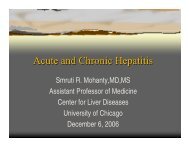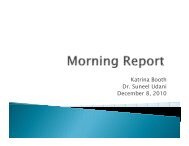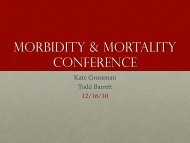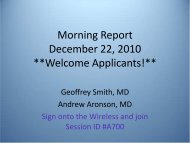Pulmonary Infiltrates in Immunocompromised Px
Pulmonary Infiltrates in Immunocompromised Px
Pulmonary Infiltrates in Immunocompromised Px
Create successful ePaper yourself
Turn your PDF publications into a flip-book with our unique Google optimized e-Paper software.
Morn<strong>in</strong>g Report<br />
Ryan Dunn<br />
Dr. David Pitrak<br />
21-Oct-2011<br />
PLEASE SWIPE!!
A 25-year 25 year-old old pregnant woman at 25 weeks’ weeks<br />
gestation undergoes a new-patient new patient evaluation. She<br />
has recently diagnosed HIV <strong>in</strong>fection and has<br />
never taken antiretroviral therapy. Her current<br />
CD4 cell count is 550/µL, 550/ L, and her HIV RNA viral<br />
load is 20,000 copies/mL copies/ mL. . She takes no<br />
medications except for a daily prenatal vitam<strong>in</strong>.<br />
Physical exam<strong>in</strong>ation, <strong>in</strong>clud<strong>in</strong>g vital signs, is<br />
normal.
1.<br />
2.<br />
3.<br />
4.<br />
MKSAP<br />
Which of the follow<strong>in</strong>g is the most appropriate<br />
management of this patient?<br />
Initiate antiretroviral therapy when CD4 cell<br />
count is
Please make your selection...<br />
1.<br />
2.<br />
3.<br />
4.<br />
Initiate antiretroviral<br />
therapy when CD4 cell<br />
count is
MKSAP<br />
This patient should receive immediate therapy<br />
with zidovud<strong>in</strong>e, zidovud<strong>in</strong>e,<br />
lamivud<strong>in</strong>e, and lop<strong>in</strong>avir-<br />
ritonavir. ritonavir.<br />
Antiretroviral therapy is recommended<br />
<strong>in</strong> all pregnant women with HIV <strong>in</strong>fection,<br />
regardless of virologic, virologic,<br />
immunologic, or cl<strong>in</strong>ical<br />
parameters, to prevent mother-to mother to-child child<br />
transmission. Therefore, <strong>in</strong>itiat<strong>in</strong>g antiretroviral<br />
treatment at delivery or when the CD4 cell count<br />
drops below 500/µL 500/ L is not appropriate.
MKSAP<br />
The treatment pr<strong>in</strong>ciples used <strong>in</strong> management of<br />
nonpregnant<br />
adults with HIV <strong>in</strong>fection also apply<br />
to pregnant women with HIV <strong>in</strong>fection; however,<br />
the benefits versus the risks to the woman, fetus,<br />
and <strong>in</strong>fant must be weighed. Some agents are<br />
harmful to the mother or the fetus and must be<br />
avoided dur<strong>in</strong>g pregnancy. Early fetal exposure to<br />
efavirenz-conta<strong>in</strong><strong>in</strong>g efavirenz conta<strong>in</strong><strong>in</strong>g regimens has been reported<br />
to cause neural tube defects. Efavirenz<br />
is the only<br />
antiretroviral agent listed as a U.S. Food and Drug<br />
Adm<strong>in</strong>istration pregnancy risk category D drug.
47 year old female presents with nausea and<br />
vomit<strong>in</strong>g from cl<strong>in</strong>ic
Pert<strong>in</strong>ent positives<br />
Five days of nausea and vomit<strong>in</strong>g 2-3 times a day<br />
one day of loose stools<br />
Compla<strong>in</strong>s of some mild fatigue dur<strong>in</strong>g that time<br />
Has had a low-grade, mild non-productive cough for last few days<br />
Pert<strong>in</strong>ent negatives<br />
No shortness of breath, no fevers/chills, no other URI symptoms<br />
besides a mild non-productive cough, No abdom<strong>in</strong>al pa<strong>in</strong>,<br />
No abdom<strong>in</strong>al pa<strong>in</strong>, No diarrhea. No dysuria or flank pa<strong>in</strong><br />
No myalgias or rash, no neck stiffness or photophobia<br />
No recent antibiotic exposure
Past medical hx –<br />
Autoimmune myelofibrosis<br />
Type 2 DM<br />
HL<br />
Psoriasis<br />
PSH - NC<br />
Allergies –NC<br />
Family Hx -NC<br />
Social Hx – On disability. Married with 2 children. No drugs,<br />
smok<strong>in</strong>g or ETOH abuse. No pets or recent travel.<br />
Medications: Campath (for > 6 months), Famiciclovir,<br />
Esomeprazole, Simvastat<strong>in</strong>
Vitals –37.3, 122, 123/74, 16, Sp02 – 97% RA<br />
General – Frail African american female NAD<br />
HEENT –Oropharynx mildly erythemtous w/o exudate. No<br />
cervical adenopathy, nasopharynx clear. No s<strong>in</strong>us<br />
tenderness<br />
CV – Tachycardic. Soft murmur but no S3/S4, neck ve<strong>in</strong>s<br />
flat.<br />
Pulm – Non-labored. Soft crackles noted over mid-lung<br />
fields bilaterally. No rhonchi/or wheezes.<br />
Abd – Soft, NT. Obese. No hepatosplenomegaly on exam.<br />
+bs.<br />
MSK – No edema. Warm. 2+LE pulses. Brisk cap refill<br />
Neuro – Ax0 x3. No focal deficits. CN2-12 <strong>in</strong>tact. No<br />
men<strong>in</strong>gismus
8.3<br />
131 94<br />
4.2 22<br />
13<br />
Labs<br />
UA – Dark yellow, 3+blood, 2+prote<strong>in</strong>, (+) leuk est, est,<br />
(-) ( ) nitrite, WBC 10-20, 10 20, Few bacteria<br />
Blood cultures and ur<strong>in</strong>e cultures pend<strong>in</strong>g<br />
C.Diff PCR – Pend<strong>in</strong>g<br />
20<br />
0.9<br />
150<br />
115<br />
PMN: 95%<br />
Lymp: 1%<br />
Ca 10.6<br />
Anyth<strong>in</strong>g make you more concerned for this patient?<br />
40.1 13.5<br />
1.3<br />
8.1<br />
0.5 0.3/0.2<br />
25 33<br />
47<br />
3.9
Differential?
Infectious (up to 50-75% of pts<br />
<strong>in</strong> some studies*)<br />
Bacteria (pneumococcus, s.aureus,<br />
gram negatives, Nocardia)<br />
Fungal (aspergillus, mucor, candida,<br />
cryptococcus, pneumocystis jiroveci,<br />
endemic fungi)<br />
Viral (HSV, CMV, RSV, <strong>in</strong>fluenza,<br />
HMPV)<br />
Mycobacterial (MAI or TB)<br />
*CHEST January 2004 vol. 125 no. 1 260-271<br />
Non-<strong>in</strong>fectious<br />
Atypical pulmonary edema<br />
Alveolar hemorrhage<br />
COP/BOOP<br />
PTLD<br />
Engraftment syndrome<br />
Drug toxicity<br />
Extension of underly<strong>in</strong>g malignancy –<br />
solid tumors, lymphoma,<br />
bronchoalveolar cancer<br />
Iatrogenic – Medication toxicity
Conventional bacteria – 37%<br />
Fungi – 14%<br />
Viruses - 15%<br />
Pneumocystis jirovcii – 8%<br />
Nocardia - 7%<br />
Mycobacterium tuberculosis –<br />
Mixed <strong>in</strong>fections – 20 %<br />
1%<br />
Highly dependent on population –<br />
Neutropenia, HIV…..etc.<br />
SOT, HSCT,
Immunodeficiency Predom<strong>in</strong>ant pulmonary<br />
<strong>in</strong>fection<br />
Humoral<br />
Phagocytic<br />
Cell-mediated<br />
Cell mediated<br />
immunodeficiency<br />
immunodeficiency Pyogenic<br />
bacterial<br />
pneumonia<br />
cell deficiency Bacterial and fungal<br />
pneumonias (esp ( esp<br />
Aspergillus), Aspergillus),<br />
candidemia<br />
with pulmonary<br />
<strong>in</strong>volvement, cryptococcus<br />
PCP PNA, legionella, legionella,<br />
Nocardia, Nocardia,<br />
CMV,<br />
cryptococcus,<br />
cryptococcus,<br />
Mycobacterial<br />
Cl<strong>in</strong>ical sett<strong>in</strong>gs<br />
Hypogammaglobul<strong>in</strong>emia,<br />
Hypogammaglobul<strong>in</strong>emia,<br />
CLL, Multimple<br />
myeloma<br />
Chemo-<strong>in</strong>duced<br />
Chemo <strong>in</strong>duced<br />
neutropenia, neutropenia,<br />
AML<br />
Lymphoma, ALL, high-dose high dose<br />
steroids, Organ<br />
transplantation, advanced<br />
HIV (AIDS), Campath<br />
therapy
Imag<strong>in</strong>g?<br />
Other tests?<br />
Empiric coverage?
L<strong>in</strong>gular consolidation, two right upper lobe<br />
nodules, trace left pleural effusion
•<br />
•<br />
•<br />
Patient started on Vancomyc<strong>in</strong>, Meropenem,<br />
Valgancyclovir and Voriconazole<br />
Sputum cultures sent, Sputum PCP assay,<br />
Ur<strong>in</strong>ary strep pneumo Ag, Ur<strong>in</strong>ary Legionella<br />
Ag and Ur<strong>in</strong>ary Histo Ag – Negative<br />
Further tests?
Historically the reported yield as been<br />
suggested to range from 15% - 93%<br />
Role of Flexible Bronchoscopy, <strong>in</strong> <strong>Immunocompromised</strong><br />
Patients With Lung <strong>Infiltrates</strong><br />
Ja<strong>in</strong> et al; CHEST February, 2004;
Etiology F<strong>in</strong>al<br />
diagnosis<br />
Dx<br />
by FB Dx<br />
by SLB Cl<strong>in</strong>ical Dx<br />
Infectious 47(36.7) 38(80.9) 4(8.5) 5(10.6)<br />
Bacterial 23(18) 18(78.3) 1(4.3) 4(17.4)<br />
Fungal 10(7.8) 8(80) 1(10) 1(10)<br />
Viral 12(9.4) 10(83.3) 2(16.7)<br />
PCP 2(1.5) 2(100)<br />
DAH 19(14.8) 17(89.5) 2(10.5)<br />
Other 86 27 17 40<br />
Total 128 72(56.2) 17(13.3) 39(30.5)
Diagnostic yield of flexible bronchoscopy was<br />
56% - Higher for <strong>in</strong>fectious vs. non-<strong>in</strong>fectious<br />
causes [ (81%) vs. (40%)].<br />
BAL and TBB (Transbronchial bx) yielded<br />
similar diagnostic yields with the comb<strong>in</strong>ation<br />
be<strong>in</strong>g better than BAL alone.<br />
BAL is best for bacterial and viral etiologies but<br />
is less sensitive for fungal pathogens (only dx<br />
40% of cases)<br />
Protected-specimen brush (PSB) sampl<strong>in</strong>g did<br />
not improved diagnostic yield.
Chest, 2002; Rano<br />
et al.<br />
Studied prognostic factors <strong>in</strong> Non-HIV IC hosts<br />
with pulmonary <strong>in</strong>filtrates<br />
Prospective, observational study with 200 pts<br />
out of Spa<strong>in</strong>.<br />
Ma<strong>in</strong> goal: Investigate prognostic factors<br />
related to mortality us<strong>in</strong>g a multiple logistic<br />
regression model
Key f<strong>in</strong>d<strong>in</strong>gs – 3 variables were significantly<br />
associated with mortality<br />
1) APACHE score > 20 (OR 5.5)<br />
2.) Need for Mechanical Ventilation (OR 28)<br />
3.) Delay of > 5 days <strong>in</strong> establish<strong>in</strong>g a specific<br />
diagnosis (OR 3.4)<br />
<br />
Rema<strong>in</strong>ed true when adjusted for<br />
patients “too sick” to undergo<br />
bronchosopy <strong>in</strong> study
<strong>Pulmonary</strong> service consulted and<br />
bronchoscopy with BAL performed<br />
Gram sta<strong>in</strong> – Oral flora<br />
PCP assay – Negative<br />
CMV PCR – Negative<br />
AFB smear – Negative<br />
Day 3 BAL culture<br />
→
Aerobic, filamentous, branch<strong>in</strong>g gram positive rod found<br />
world wide <strong>in</strong> soil frequently <strong>in</strong>dist<strong>in</strong>guishable from<br />
act<strong>in</strong>omyces on sta<strong>in</strong><br />
N<strong>in</strong>e pathogenic stra<strong>in</strong>s of Nocardia sp responsible for<br />
human disease<br />
N. Asteroides complex (actually 5 stra<strong>in</strong>s of Nocardia) is most<br />
common cause of systemic and pulmonic disease worldwide<br />
> 60% of cases seen <strong>in</strong> patients with impaired host immunity<br />
<strong>in</strong>clud<strong>in</strong>g (usually cell mediated): Lymphoma, HIV<br />
(CD4
<strong>Pulmonary</strong> disease<br />
Predom<strong>in</strong>ant cl<strong>in</strong>ical manifestation (40% of cases)<br />
May manifest as endobronchial mass, pneumonia, empyema, lung abcess or<br />
nodular, cavitary disease<br />
Radiographically may appear as nodules (frequent cavitations), reticulonodular<br />
or diffuse <strong>in</strong>filtrates<br />
“Secondary cerebral localization and cl<strong>in</strong>ically silent destructive <strong>in</strong>fection are<br />
sufficiently common that cerebral imag<strong>in</strong>g, preferably magnetic resonance<br />
imag<strong>in</strong>g (MRI), should be performed <strong>in</strong> all cases of pulmonary and dissem<strong>in</strong>ated<br />
nocardiosis.”<br />
ALWAYS IMAGE BRAIN FOR OCCULT DISSEMINATION!<br />
Also beware of dissem<strong>in</strong>ation to other organs<br />
Mandell: Pr<strong>in</strong>ciples and Practice<br />
of Infectious Disease, 2009
Mandell: Pr<strong>in</strong>ciples and Practice of Infectious Disease
Primay cutaneous – Similar to staph/strep cutaneous<br />
<strong>in</strong>fections<br />
Lymphocutaneous – “Sporotrichoid Nocardia” (i.e<br />
Lymphangitis)<br />
<br />
Cutaneous<br />
<strong>in</strong>volvment<br />
from dissem<strong>in</strong>ated disease<br />
Mycetoma – Chronic cutaneous <strong>in</strong>fection typically found<br />
on feet that may also be caused by fungi. Most commonly<br />
caused by N. Brazil<strong>in</strong>sis
“Madura Foot”
Dissem<strong>in</strong>ated disease<br />
<br />
<br />
<br />
<br />
Difficult to isolate <strong>in</strong> blood cultures because it is<br />
fastidious organism<br />
Insidious presentations are not uncommon with a<br />
paucity of systemic or laboratory abnormalities <br />
May be mistaken for malignancy<br />
May also dissem<strong>in</strong>ate to other sites (bone, heart<br />
valves, sk<strong>in</strong>, kidneys, jo<strong>in</strong>ts etc.)<br />
Remember tropism for CNS ( up to 44% of cases)!
Diagnosis rests upon isolat<strong>in</strong>g the organism from<br />
tissue or blood cultures<br />
Nocardia sp are fastidious and usually take up 3-5 days<br />
to isolate but may take longer – the microbiology lab<br />
should be notified if Nocardia is suspected<br />
The organism is weakly acid-fast
Lack of cl<strong>in</strong>ical trials makes optimal treatment unclear<br />
Trimethroprim/Sulfamethaxazole is historically<br />
backbone of therapy<br />
There may be <strong>in</strong>creas<strong>in</strong>g rates of resistance to<br />
TMP/SMX (as high 42% 6 )<br />
Susceptibility test<strong>in</strong>g should ALWAYS be peformed<br />
M<strong>in</strong>or disease typically treated with TMP/SMX<br />
Dissem<strong>in</strong>ated disease treated with TMP/SMX +<br />
Amikac<strong>in</strong> or Beta-Lactam +Amikac<strong>in</strong><br />
Life threaten<strong>in</strong>g disease is treated with triple therapy
Switch to PO regimen at 3-6 weeks<br />
Simple cutaneous<br />
disease: 7-8 weeks<br />
<strong>Pulmonary</strong> or dissem<strong>in</strong>ated disease w/o CNS<br />
<strong>in</strong>volvement: 6 months at least<br />
CNS <strong>in</strong>volvment: 12 months<br />
Mandell: Pr<strong>in</strong>ce and Practice<br />
Infectious Disease 2009
Cutaneous<br />
Pleuropulmonary<br />
diseases: 100% cure rate<br />
disease: 90% cure rate<br />
Dissem<strong>in</strong>ated disease: 60% cure rate<br />
Bra<strong>in</strong> abcess: 50% cure rate<br />
Arch Int Med 1983; 143:711-718
MOA: b<strong>in</strong>ds CD52 on lymphocytes and<br />
leukemic cells <strong>in</strong> causes cell death <strong>in</strong> leukemic<br />
cells<br />
Uses: B-cell CLL and other<br />
lymphoma/leukemias<br />
Side effects: Causes severe lymphopenia <strong>in</strong><br />
97%. Also causes myelosuppression result<strong>in</strong>g<br />
<strong>in</strong> other cytopenias less commonly<br />
Patients CD4 counts should be monitored and<br />
they should be provided with TMP/SMX<br />
prophylaxis when below 200
Patient started on TMP/SMX and Imipenem<br />
Speciation and susceptibility of Nocardia<br />
pend<strong>in</strong>g.<br />
Patients fever, cough and gastro<strong>in</strong>test<strong>in</strong>al<br />
symptoms have resolved. Will follow up <strong>in</strong> ID<br />
cl<strong>in</strong>ic for tailor<strong>in</strong>g of antibiotic therapy.<br />
sp
Recognize the differential for pulmonary <strong>in</strong>filtrates <strong>in</strong><br />
immunocompromised host and the importance of early<br />
diagnosis<br />
Recognized common manifestations of Nocardiosis<br />
and basic management of the disease<br />
Consider type of immunosuppression when<br />
approach<strong>in</strong>g and <strong>in</strong>fected IC host<br />
Campath (Alemtuzamab) causes severe lymphopenia<br />
that should be monitored like AIDS/HIV



